|
|
|
Published
on 27
Jun 2009
|
All rights reserved.
|
|
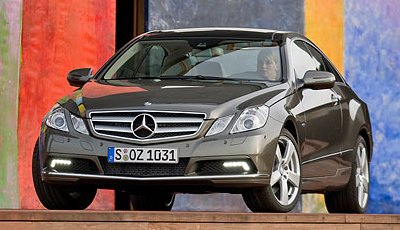
|
By switching to the E-class name,
Mercedes hopes the coupe will have a psychological advantage over its
rivals.
|
In 1968,
Mercedes-Benz
introduced a hardtop coupe based on its mid-sized W114 saloon. The
250CE, where C stands for Coupe, was renowned for mechanical refinement
and an elegant style by its Italian designer Bruno Sacco. That was the
ancestor of today's E-class Coupe. Mercedes produced three generations
of CE coupes before switching to the smaller CLK-class from 1997. While
the latter was a commercial success, it had been finding more and more
difficult to fend off the competition from BMW 3-Series Coupe, Audi A5
and Infiniti G37 Coupe. These cars are more dynamically capable yet
cheaper to purchase. In order to sustain a price premium, the product
planners at Stuttgart decided to terminate the CLK line and go back to
its mid-size strategy. As a result, E-class Coupe is born.
By switching to the E-class name, Mercedes hopes the coupe will have a
psychological advantage over its rivals, because customers can clearly
see its classier status. Moreover, it is part of the company's strategy
to reduce its increasingly confusing nameplates. As we know, the next
generation CL coupe will also be renamed to S-class Coupe.
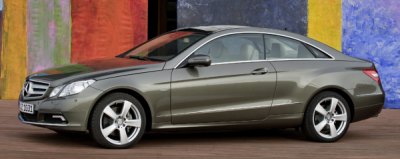
|
Its sleek profile enables a world
record-breaking Cx of 0.24
|
The
relationship between E-class Coupe and E-class saloon is evident from
its quad-diamond-shape headlights. But everything else is different.
There is not a single body panel shared between the two cars as their
dimensions and shapes are very different. The Coupe has a much sleeker
profile. Its windshield and rear screen are set at fast angles to
enable a world record-breaking Cx of 0.24, i.e., one point better than
the saloon. Its slopping bonnet is headed by a grille and 3-pointed
star badge traditionally reserved for Mercedes coupes. Its side glasses
are heavily tapered towards the roof to create a sportier feel. The
power bulges around rear fenders have a similar intention. The
frameless doors and B-pillarless hardtop design bring a cleaner side
view. There is some CLS-class flavours in the banana-shape waistline.
However, like the sedan, the E-class Coupe is not a good example of
automotive design. I particularly dislike its complicated front end,
whose angular elements contrast the smooth body profile. Moreover, the
high and curvy waistline creates a sense of fatness so that the rear
wheels look at least a couple of inches smaller than they should be. On
the road, this car might be as head-turning as CLS because of its
heavy-handed design, but from purist point of view it has little to
remember.
The interior of E-class Coupe adopts a design similar to its saloon
sibling, which means intuitive, high-quality and robust.
But since this is a coupe, we should expect something more stylish,
shouldn't we ? Fortunately, those good-looking leather seats save the
game. The front seats are not only supportive and comfortable, they are
also set low enough in the cabin. The two individual rear seats have a
similar sporty design as the front (like Porsche Panamera), what a pity
they are not the most accommodative in the class - while legroom is
abundant, people over 5' 9" (175cm) will have their heads touching the
sloping roof. All passengers are cocooned by a high waistline, but a
light
and airy ambience is made possible by a panoramic glass roof,
remarkably narrow roof rails and the
lack of B-pillars.

|
More style would be welcomed to the
interior
|
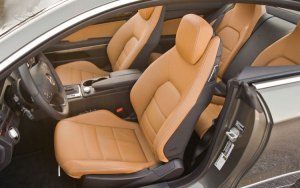 |
|
As in the sedan, you can have a wide range of luxury, infotainment and
safety features. However, I suppose our readers are more interested in
the mechanical aspect. Although E-class Coupe is supposed to be the
coupe version of E-class, I found it actually owes more to the C-class.
Look at
its dimensions: this car is 117 mm longer than C-class and 170 mm
shorter than E-class, 16 mm wider than C-class and 68 mm narrower than
the
E-class, so it is closer to the former. Most
important, its 2760 mm wheelbase is identical to the smaller saloon.
What do you think ? Yes, it might be derived from the C-class. Mercedes
insisted that it employs more components from E-class than C-class,
such as suspensions and powertrains. It just didn't tell us that the
new E-class has already switched to C-class suspensions. Moreover, the
Coupe does not get Airmatic suspensions, unlike E-class. As for
powertrains, it is meaningless to say which ones come from E-class
because Mercedes' powertrains are always designed independent of cars.
Any new models are free to adopt suitable powertrains from the enormous
parts pool.
5 engines are offered on the Coupe: 204hp 1.8 direct-injection turbo
(E250CGI), 204hp 2.1 twin-turbo diesel (E250CDI), 231hp 3.0 turbo
diesel V6 (E350CDI), 292hp 3.5 direct-injection V6 (E350CGI) and 388hp
5.5 V8 (E500 or E550). As you have read from our E-class report, the V8
offers serious performance but its asking price is out of the reach of
most buyers. Moreover, its extra weight compromises handling a little.
The petrol V6 looks powerful on paper, but in reality it lacks
instantaneous torque compared with
BMW's twin-turbo straight-six or Audi's supercharged V6, so it is not
the
best choice here. The diesel V6 is worth more recommendation for its
combination of real world performance and respectable refinement,
though a low-revving diesel engine is hardly an inspiring choice. The
same goes for the four-cylinder E250CGI, which is
willing and refined, if not very quick. It represents great value for
money. We
praised the four-cylinder diesel E250CDI in our E-class saloon report.
In the lighter and sleeker coupe, it delivers an even more incredible
fuel economy (55.3 mpg) and emission (135g/km CO2).
Nevertheless,
the engine is coarse whenever being pushed to upper rev range, thus it
can hardly satisfy enthusiastic drivers.
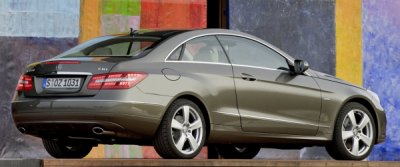
|
The best part of this car should be
comfort and refinement...
|
On the road, the E-class Coupe shows considerable improvement in
handling compared with the previous CLK. There is a new sense of speed
and accuracy from its variable-ratio steering rack.
The chassis shows tighter body control and better balance in corners.
Understeer is better suppressed. Such improvements are brought by the
"Agility Control" suspensions, which employ two-stage mechanical
adaptive dampers. If you opt for "Dynamic Handling" pack, which is an
affordable option on all sport models and standard on E500, you'll also
get electronic continuous adaptive damping, gearshift paddles and a
Sport button which switch to sportier suspension, throttle and
transmission mapping. You can have the E-class Coupe set
as a sports coupe or a comfort coupe depending on your mood. In sport
mode, it flows through winding back roads more fluently, giving you
more confidence. Admittedly, even then the Mercedes coupe is not as
agile as a BMW 3-Series Coupe in sport suspensions. To preserve a ride
quality that Mercedes needs, it leaves some body roll and understeer
unrectified.
In Comfort mode, or on standard suspensions without Dynamic Handling
pack, the E-class Coupe rides nicely - slightly firmer than E-class
saloon but perfectly suitable to a civilized coupe. Only the E500 on 18-inch rims
and
low-profile tires would generate some harshness over bumpy roads.
Unsurprisingly, the best part of E-class Coupe is still comfort and
refinement, especially how it is driven
relaxingly cross country. The way it cruises at high speed with little
wind noise, engine noise and road noise is impressive. Its high-speed
stablity, its refined steering and ride ease your fatigue over long
journey, let you enjoy the great view from the paranomic glass house.
Use the Command voice recognition to play your favourite Jazz, let the
radar cruise control, lane departure warning and blindspot warning to
relieve your pressure... relax... and relax... Just as you fall
asleep, the drowsy alert sounds a warning chime to wake you up. It's
time to have a coffee at road side cafe. If you enjoy luxury motoring,
E-class Coupe should be the cheapest entry point. |
Verdict:     |
Published
on 6
Mar 2010
|
All rights reserved.
|
|
E-class Cabriolet
|
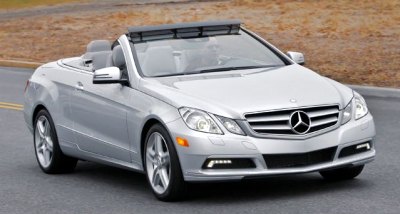
|
Even at 70 mph, you can talk in
regular volume to passengers at the back. Such refinement is
unprecedented in the open-air motoring world...
|
It
is easy to see why Mercedes E-class Cabriolet can charge more money
than the equivalent BMW 3-series Cabriolet or Audi A5 Cabriolet. The
family name E-class might help, but from many areas you can feel the
Mercedes open-air car is better designed and more exclusive than its
counterparts. One problem is common to its rivals: they look like
coupes minus roofs. That is to say in pursuit of open-air motoring, you
have to sacrifice a little bit style. The Mercedes is on the contrary.
While the E-class Coupe looks a little bulky, cutting the roof actually
makes the Cabriolet slimmer and more charming. So this is not a coupe
minus something, but plus something.
Another thing I don't like other cabriolets is they treat rear
passengers as second-class citizens. Not so in the E-class Cabriolet.
Six-footers can sit comfortably at the back unless the front occupants
are unusually tall.
Space aside, Mercedes seems to understand the needs of open-air
motorists better than everyone else. If you want to enjoy sunshine in
winter, the "Airscarf" seat blows hot air to keep your neck warm. If
your rear passengers dislike the wind buffeting at cruising speed, you
can activate the new "Aircap" feature, which deploys an aerodynamic
foil a few inches from the windscreen header, deflecting the air flow
upward and greatly reducing buffeting to the rear passengers. It also
makes the cabin a lot quieter. Even at 70 mph, you can talk in regular
volume to passengers at the back. Such refinement is unprecedented in
the open-air motoring world.
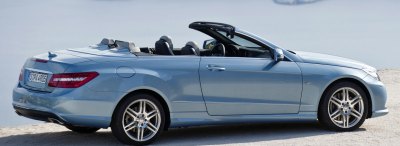
|
Jumping from the E-class coupe to the
cabriolet would not find a remarkably difference in driving fun - or
the lack of it.
|
Unlike
BMW,
Mercedes wisely decided to keep using conventional fabric roof instead
of switching to folding metal roof. This result in a weight increase of
120 kg, versus 210 kg in the case of BMW 3-Series Cabriolet. Mercedes'
3-layer soft roof is a quality work. It keeps the cabin quiet at
motorway speed. It opens or closes in just 20 seconds, and is operable
at speed up to 25 mph. It eats little trunk space. Luggage volume is
390 liters with the roof up or 300 liters with it stored, much better
than BMW's 350 and 210 liters respectively.
Expectedly, the cabriolet is not quite as stiff as the coupe despite of
some underfloor reinforcement. However, by the standard of cabriolets
its chassis rigidity or running refinement is beyond criticism. Unless
you push it on really bad roads, the E-class Cabriolet hardly shows any
scuttle shake or chassis flex. On regular roads, you can expect superb
refinement in terms of ride and powertrain smoothness.
A wide range of petrol and diesel engines are available. Best selling
of them should be the 292-horsepower direct-injected V6 of 350CGI.
However, we find the 3.0-liter V6 turbo diesel of 350CDI the sweetest
of all. It is not only more frugal but also more refined than the
slightly underachieved 350CGI. On paper, it hardly loses any
performance to the petrol V6. In real world, you will feel the
difference made by its 398 pound-foot of torque from just 1600 rpm,
which translates to instant acceleration when you need to overtake
other cars. Moreover, the mountain of torque calms down the 7G-Tronic
gearbox, which is busier in hunt for gears in the 350CGI. The V6 turbo
diesel could have made the range-topping 5.5-liter V8 redundant if America were offered with super
low sulfur diesel.
Then what about handling ? Considering cabriolets are designed for more
laid-back driving style, the E-class Cabriolet's emphasis on refinement
is more suitable to the task than either 3-Series Cabriolet or A5
Cabriolet. At least, jumping from the E-class coupe to the cabriolet
would not find a remarkable difference in driving fun - or the lack of
it. The same cannot be said to BMW. For all these reasons, Mercedes
deserves the slight premium it asks for. |
Verdict:     |
Published
on 27
Apr 2014
|
All rights reserved.
|
|
E400 Coupe & Cabriolet
|
|
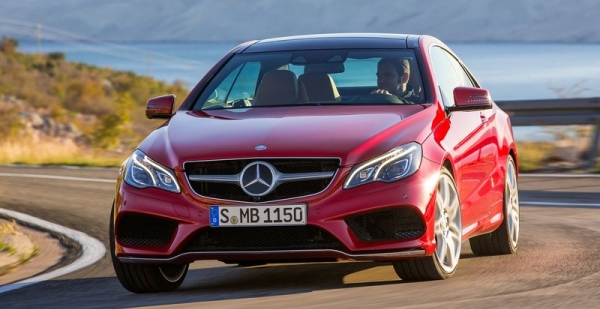
|
Like the rest of the
E-class range, the E-class Coupe and Cabriolet duo got a comprehensive
facelift last year. Its new nose looks far more stylish than the
original design (which used to catch my criticism), although the
too-high waistline is still unresolved.
Under the sheet metal, the chassis received a new variable-ratio
electrical power steering which is both more responsive and better
weighted. The engine range was updated, too. At entry level, the old
M271 1.8-liter turbo was replaced with the new M274 2-liter with 211 hp
and 258 lbft. At the other extreme, flagship E500 got the new 4.7-liter
twin-turbo DI V8 instead of the aging 5.5-liter. However, the most
significant is probably the addition of E400, which employs an all-new
3-liter twin-turbo V6. To those complaining the naturally
aspirated E350 lacks sparkles, this could be the answer.
The new V6 runs a conventional 60-degree V-angle so that it can skip
the
energy-wasting balancer shaft that served the previous Mercedes V6s.
Equipped with spray-guided direct injection with high-pressure piezo
injectors and dual-variable cam phasing, high efficiency is guaranteed.
It produces 333 horsepower and 354 lbft of torque. The latter easily
overwhelms the similar engines of BMW 435i (295 lbft) and Audi S5 (324
lbft). Moreover, this does not come at the expense of tractability. The
peak torque is available from an incredibly low 1400 rpm and sustains
until 4000 rpm. On the road, this gives the E400 Coupe and Cabriolet a
stronger sense of power and flexibility than its rivals. The superior
low end torque also allows the Mercedes to play power slide easily like
a V8 muscle car. In normal driving, the new motor is smooth and
refined, working in harmony with the 7G-Tronic Plus automatic.
Unfortunately, the gearbox does not respond well to committed drive.
Every flick of the gearshift paddle is followed by a noticeable delay,
ruining the driving excitement a little. You won't find the same on the
ZF automatic on BMW or the twin-clutch box on Audi. Sooner or later
Mercedes should rethink
whether to continue building its own automatic transmissions.
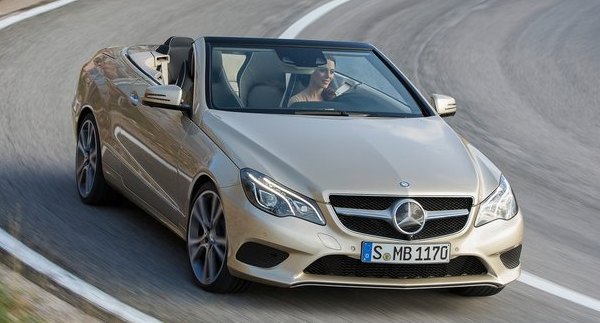
|
Being heavier and less well balanced, the E-class Coupe is not as agile
as BMW 4-Series and its body control
is not as good, but its handling is perfectly decent for a 4-seat
luxury coupe.
Equip it with electronic adaptive dampers and choose the
right wheels/tires option, you can get a car offering cosseting ride
and decent control. The grip, the steering and brakes are all up to the
job. As a cross-country cruiser it works better than the BMW, thanks to
its superior ride comfort, more interior space (especially rear
legroom)
and larger boot. Meanwhile, the Cabriolet still tops the class with its
good blend of comfort and excellent wind management.
|
Verdict:     |
|
|
|
|
|
|
|
|
|
|
E250
CGI Coupe
|
2009
|
| Front-engined,
RWD |
| Steel monocoque |
| Mainly steel |
| 4698 / 1786 / 1397 mm |
| 2760 mm |
Inline-4
|
| 1796 cc |
DOHC 16 valves, VVT
|
| Turbo |
| DI |
204 hp
|
229 lbft
|
5-speed automatic
|
F: 3-link strut
R: multi-link
|
| Mechanical adaptive damping |
235/45R17
|
1505 kg
|
154 mph (c)
|
6.8 (c) / 7.4***
|
| 19.6*** |
|
E350
CGI Coupe
|
2009
|
| Front-engined,
RWD |
| Steel monocoque |
| Mainly steel |
| 4698 / 1786 / 1397 mm |
| 2760 mm |
V6, 90-degree
|
| 3498 cc |
DOHC 24 valves, VVT
|
| VIM |
| DI |
292 hp
|
269 lbft
|
7-speed automatic
|
F: 3-link strut
R: multi-link
|
| Mechanical adaptive damping |
235/45R17
|
1595 kg
|
155 mph (limited)
|
6.0 (c)
|
| - |
|
E500
Coupe
|
2009
|
| Front-engined,
RWD |
| Steel monocoque |
| Mainly steel |
| 4698 / 1786 / 1397 mm |
| 2760 mm |
V8, 90-degree
|
| 5461 cc |
DOHC 32 valves, VVT
|
| VIM |
| - |
388 hp
|
391 lbft
|
7-speed automatic
|
F: 3-link strut
R: multi-link
|
| Electronic adaptive damping |
F: 235/40ZR17
R: 255/35ZR18
|
1640 kg
|
155 mph (limited)
|
5.2 (c) / 4.8* / 4.7**
|
11.5* / 11.1**
|
|
|
|
|
|
Performance
tested by: *C&D, **R&T, ***Autocar
|
|
|
|
|
|
|
E350
CGI Cabriolet
|
2010
|
| Front-engined,
RWD |
| Steel monocoque |
| Mainly steel |
| 4698 / 1786 / 1398 mm |
| 2760 mm |
V6, 90-degree
|
| 3498 cc |
DOHC 24 valves, VVT
|
| VIM |
| DI |
292 hp
|
269 lbft
|
7-speed automatic
|
F: 3-link strut
R: multi-link
|
| Mechanical adaptive damping |
235/45R17
|
1715 kg
|
155 mph (limited)
|
6.5 (c)
|
| - |
|
E350
CDI Cabriolet
|
2010
|
| Front-engined,
RWD |
| Steel monocoque |
| Mainly steel |
| 4698 / 1786 / 1398 mm |
| 2760 mm |
V6 diesel, 72-degree
|
| 2987 cc |
DOHC 24 valves
|
VTG turbo
|
| CDI |
231 hp
|
398 lbft
|
7-speed automatic
|
F: 3-link strut
R: multi-link
|
| Mechanical adaptive damping |
235/45R17
|
1770 kg
|
155 mph (limited)
|
6.6 (c)
|
| - |
|
|
|
|
|
|
Performance
tested by: -
|
|
|
|
|
|
|
E250
Coupe
|
2013
|
| Front-engined,
RWD |
| Steel monocoque |
| Mainly steel |
| 4703 / 1786 / 1397 mm |
| 2760 mm |
Inline-4
|
| 1991 cc |
DOHC 16 valves, DVVT
|
| Turbo |
| DI |
211 hp
|
258 lbft
|
7-speed automatic
|
F: 3-link strut
R: multi-link
|
| Mechanical adaptive damping |
235/45R17
|
1560 kg
|
155 mph (limited)
|
6.7 (c)
|
| - |
|
E400
Coupe
|
2014
|
| Front-engined,
RWD |
| Steel monocoque |
| Mainly steel |
| 4703 / 1786 / 1397 mm |
| 2760 mm |
V6, 60-degree
|
| 2996 cc |
DOHC 24 valves, DVVT
|
| Twin-turbo |
| DI |
333 hp
|
354 lbft
|
7-speed automatic
|
F: 3-link strut
R: multi-link
|
| Electronic adaptive damping |
F: 235/40ZR18
R: 255/35ZR18
|
1650 kg
|
155 mph (limited)
|
5.0 (c) / 4.9*
|
| 12.2* |
|
E500
Coupe
|
2013
|
| Front-engined,
RWD |
| Steel monocoque |
| Mainly steel |
| 4703 / 1786 / 1397 mm |
| 2760 mm |
V8, 90-degree
|
| 4663 cc |
DOHC 32 valves, DVVT
|
| Twin-turbo |
| DI |
408 hp
|
442 lbft
|
7-speed automatic
|
F: 3-link strut
R: multi-link
|
| Electronic adaptive damping |
F: 235/35ZR18
R: 255/30ZR18
|
1740 kg
|
155 mph (limited)
|
4.6 (c)
|
| - |
|
|
|
|
|
Performance
tested by: *C&D
|
|
|
|
|
|
|
E350
Bluetec Cabriolet
|
2013
|
| Front-engined,
RWD |
| Steel monocoque |
| Mainly steel |
| 4703 / 1786 / 1398 mm |
| 2760 mm |
V6 diesel, 72-degree
|
| 2987 cc |
DOHC 24 valves
|
VTG turbo
|
| CDI |
252 hp
|
457 lbft
|
7-speed automatic
|
F: 3-link strut
R: multi-link
|
| Electronic adaptive damping |
F: 235/40ZR18
R: 255/35ZR18 |
1860 kg
|
155 mph (limited)
|
6.4 (c)
|
| - |
|
E400
Cabriolet
|
2014
|
| Front-engined,
RWD |
| Steel monocoque |
| Mainly steel |
| 4703 / 1786 / 1398 mm |
| 2760 mm |
V6, 60-degree
|
| 2996 cc |
DOHC 24 valves, DVVT
|
| Twin-turbo |
| DI |
333 hp
|
354 lbft
|
7-speed automatic
|
F: 3-link strut
R: multi-link
|
| Electronic adaptive damping |
F: 235/40ZR18
R: 255/35ZR18
|
1770 kg
|
155 mph (limited)
|
5.1 (c)
|
| - |
|
|
|
|
|
|
Performance
tested by: -
|
|
|
|
|
|
|
|
|
Copyright©
1997-2014
by Mark Wan @ AutoZine
|
|